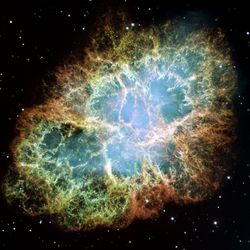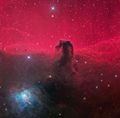Nebula
 From Conservapedia
From Conservapedia 
A nebula, from the Latin word for cloud, is a cloud of interstellar dust and gases.[1] Nebulae have been observed both within the Milky Way galaxy and in other galaxies. Nebulae consist of mostly hydrogen gas though other elements such as oxygen and nitrogen as well as organic compounds like hydrogen cyanide.[2] Secular scientists believe nebulae can form stars and planets in a way known as the nebular hypothesis, and that our solar system formed about 4.6 billion years ago in this way.[3] However this approach has several issues and flaws.[3][4] Creation scientists suggest that God created nebulae along with other astronomical object on the fourth day of Creation week (Genesis 1:16).[5]
Nebulae often feature prominently in commercially available collections of deep-space images, since their colours and shapes are interesting, varied and curiously attractive. These images are often from those taken by telescopes in space like the Hubble Space Telescope. Some well-known nebulae are the Orion nebula, the Crab nebula, and the Horsehead nebula.
Contents
- 1 History of Observation
- 2 Properties and Structure
- 3 Classification
- 4 Gallery
- 5 External links
- 6 References
History of Observation[edit]
The history of nebulae begins shortly after the invention of the telescope. In 1610, Nicolas-Claude Fabri de Peiresc first observed the Orion nebula.[6] He was the first to notice that the nebula was not a star as it appears to the naked eye. Later in 1656, Christiaan Huygens described the inner regions of the nebula and that there was in fact 4 stars at the centre Orion nebula.
Later on in the 18th century, astronomers were searching for comets in the night sky. At that time, both nebulae and comets appeared as fuzzy region when viewed through their telescopes. As a result, some astronomers mistook nebulae for comets. To counter this, astronomers began to catalogue nebulae to avoid confusion. The most well known catalogue is the Messier catalogue, a collection of over 100 objects noted by Charles Messier and published in 1781.[6] It is important to note that not all these objects are nebulae. Some objects like galaxies were originally referred to as nebulae as they possess a similar appearance through the telescopes available at that time.
In the 19th century, the astronomer William Herschel and his son John Herschel discovered thousands of nebulae, far more than anyone else.[6] In the years between 1786 and 1802, William Herschel with help from his sister Caroline discovered at least 2,500 clusters, nebulae and galaxies. John Herschel discovered a further 1,700 objects. These discoveries form a major components of the New General Catalogue created by John Dreyer in 1888.[6] Together, these form 4,630 of the 7,840 objects in the catalogue.[7]
The invention of photography in the late 1800s transformed the study of nebulae and astronomy in general. It allowed details that could not be seen with the naked eye to be seen. In 1880, the first photograph of the Orion nebula was taken, though reasonable quality images were not produced for another three years.[6] Photography also allowed for the easy study of the spectrum of astronomical objects, the resolving of an objects light into different wavelengths. This made it easy to distinguish between the glowing gas of a nebula and a collection of unresolved stars. The spectra of stars tend to consist of a broad spectrum punctuated by dark absorption lines whereas nebulae, especially emission nebulae tend to have lines only at specific wavelengths. This technique was applied to the Orion nebula in 1864 to demonstrate it was composed of hydrogen.[6] At this point, the distinction of nebulae and galaxies started to become clear. As galaxies are composed of vast numbers of stars, their spectra resembles that of a star's.
Throughout the 20th century, numerous developments in photography and astronomy in general advanced the understanding of nebulae enormously. Photographic plates became more sensitive allowing for fainter objects and more detail to be recorded. In 1930, Bernhard Schmidt invented a fast, wide angle camera that allowed for large faint objects like nebulae to be observed easily.[6] Nowadays, photographic plates have been replaced with charge coupled devices or CCDs which are over 100 times more sensitive.[6] It is now possible to use CCDs to observe in a variety of wavelengths in different regions of the electromagnetic spectrum. These include ultraviolet, infrared, x-rays, radio and optical. Viewing nebulae through different wavelengths has allowed for new insights. For example, infrared astronomy can be used to see through dust present in many nebulae as dust doesn't absorb infrared light. Computerised spectrometry can now be used to determine the main components of a nebula.
Properties and Structure[edit]
Nebulae come in a variety of shapes and size, ranging from less than 1 light year across to hundreds of light years across. There are several different classifications of nebulae including diffuse nebulae, planetary nebulae and dark nebulae. Diffuse nebulae are further split up into emission nebulae and reflection nebulae. All nebulae however consist of large clouds of gas and dust. Temperatures inside nebulae vary depending on the type but can be anywhere from 10 K to as high as 10 million K.[6] Large nebulae can contain over ten thousand solar masses of material.[5]
Most nebulae have a very similar composition, with around 90% of the atoms in the nebulae being hydrogen and much of the remaining 10% being helium.[6] This led to nebulae containing ionized hydrogen being called "H II regions," as "H II" is commonly used to denote to singly ionized hydrogen in astronomy. Other elements like nitrogen, oxygen and neon are often found as well at around two parts per thousand.[6] Compounds and organic molecules such as hydrogen cyanide, formaldehyde and methanol have also been observed in the Orion nebula.[2] Interstellar dust composed of carbon and silicates accounts for a fraction (0.7%) of the material in nebulae.[6] Typical densities in nebulae vary from hundreds to millions of hydrogen atoms per cubic centimetre.
Classification[edit]
There are several classes of nebulae, and a nebula, such as the Trifid nebula, may belong to more than one. The main classes of nebulae are:
- Diffuse nebulae - These are large but thin clouds of gas and dust.[8] These are sub classified into two types, emission nebulae and reflection nebulae. Emission nebulae, also known as H II regions, occur when high energy radiation from nearby large stars causes the nebulae to glow, normally a red color. If there are no large stars, then there may be a reflection nebulae, where the white/blue light of stars is reflected off dust.[8] This produces a blue nebula. Examples include the Lagoon nebula and the Eagle nebula.
- Planetary nebulae - These nebulae tend to be faint, fairly small (perhaps a few light years across) and are often circular or ring shaped with a shell-like structure.[9] These were named "planetary nebulae" due to their resemblance to planets when viewed through a telescope. They are often found to be expanding at a few tens of kilometres per second. Examples of planetary nebulae include the Ring nebula, the Cat's eye nebula and the Butterfly nebula.
- Dark nebulae - Also called molecular clouds, these nebulae are characterised by interstellar dust in the foreground, obscuring stars or a bright nebula in the background.[10] Some times called absorption nebulae, dark nebulae tend to be very dense and cold. Due to their dark nature, they can only really be seen via far-infrared and microwave techniques and have a temperature of 7-15 K.[10] Well known examples include the Horsehead nebula and the Coalsack nebula.
- Supernova remnants - These are the remnants of supernovae, composed of gas emitted during the supernova explosion.[11] They are often large and impressive. Only a handful have been observed in the Milky Way, but others have been seen in other galaxies. Examples include the Crab nebula and SN 1604.
Gallery[edit]
Bellow are some images of well known nebulae.
Crab Nebula

Lagoon nebula

Eagle nebula

Orion nebula

Rosette nebula

Trifid nebula

Cat's eye nebula
.jpg)
Helix nebula
Ring nebula

Boomerang nebula

Horsehead nebula

Snake nebula
External links[edit]
- Some spectacular pictures from the Hubble Telescope, which include many nebulae
- Some more images taken by the Hubble Space Telescope
References[edit]
- ↑ What is a nebula from coolcosmos.ipac.caltech.edu
- ↑ 2.0 2.1 Complex molecules in the Orion Nebula from herschel.cf.ac.uk
- ↑ 3.0 3.1 Nebular hypothesis from creation.com
- ↑ Pièrre Simon Laplace: The Nebular Hypothesis from answersingenesis.org
- ↑ 5.0 5.1 The Splendor of God’s Creation from answersingenesis.org
- ↑ 6.00 6.01 6.02 6.03 6.04 6.05 6.06 6.07 6.08 6.09 6.10 6.11 Nebula from britannica.com
- ↑ William Herschel from space.com
- ↑ 8.0 8.1 Diffuse Nebulae from messier.seds.org
- ↑ Planetary Nebulae from messier.seds
- ↑ 10.0 10.1 Molecular Clouds from britannica.com
- ↑ Supernova Remnants (SNR's) from messier.seds.org
| ||||||||||||||||||||
Categories: [Astronomy] [Nebulae]
↧ Download as ZWI file | Last modified: 02/07/2023 01:28:32 | 135 views
☰ Source: https://www.conservapedia.com/Nebula | License: CC BY-SA 3.0
 ZWI signed:
ZWI signed:

 KSF
KSF